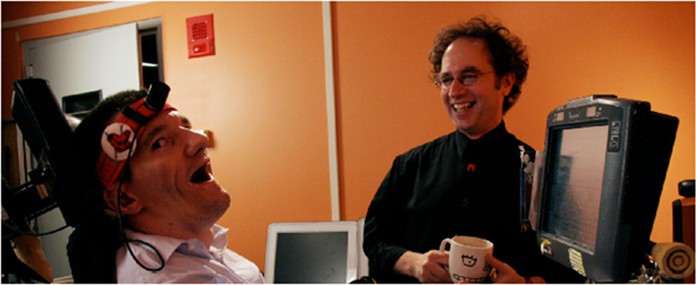He’s created a whimsical room filled with interactive electronic instruments, allowing people to interact with objects like hanging “musical pillows” and “rhythm trees” to create musical sound through exploration. He’s given the power of music to the general population through music composition programs like Hyperscore, which allow users to literally draw lines and squiggles to create musical ideas. Guitar Hero and Rock Band came out of his lab. Muriel R. Cooper, Professor of Music and Media from Massachusetts Institute of Technology, and University of California Santa Barbara’s current SAGE Center for the Study of the Mind Distinguished Fellow Tod Machover has managed to make what normally would be excluded to the domain of science fiction a reality.
Machover has been making influential contributions to the fields of music and sound for over 30 years at MIT. To hear him speak is to share part of his inspiring vision. On Jan. 11, Machover gave his third presentation in a series of four lectures through the SAGE Center for the Study of the Mind entitled “Music, Mind and Health: Diagnosis, Treatment and Well-being through Active Sound.” This particular lecture revolved around discussing how music affects the human body and mind, and its relationship with health.
Machover first discussed some of his remarkable past work, then he dove deep into talking about his music and health-based work at Tewksbury State Hospital, a Boston mental health facility. He and his team started a program that integrated music composition workshops into patients’ daily routines.
A particularly notable innovation used in patient workshops is his aforementioned composing software, Hyperscore, which uses size, color, shape and length as elements for music creation, as opposed to traditional musical notation. This visual shorthand of drawing music with a mouse, among other inventive tools such as one patient’s head laser, allows people without classical musical training to find a way to create what they hear inside themselves, allowing them an outlet for creativity and self-expression.
“From a young age, I learned that music is all around you and it’s not just something that old, dead men create on sheet music,” said Machover, explaining his drive to create Hyperscore. “And musical notation systems in place today are pretty inaccessible. It’s very powerful for everyone to have the ability to create music.”
Machover said his inspiration to work with mentally disabled patients came after the program was used with a primary audience of small children in schools.
“We had such good results with kids around the world,” said Machover. “They got motivated overnight. I began to think, ‘there must be whole other groups of people who are never invited to join in on music making.’ And there came the idea for Tewksbury.”
At Tewksbury, Machover and his team made many important observations about the beneficial effect of music on patients’ health. For example, participating in music creation helped patients with muscle control issues such as cerebral palsy have greater control over their motor skills. It also helped patients with memory loss regain some general recall, and occasionally brought back specific, detailed recollections. The workshops helped most patients regain some sense of self-efficacy.
“A common conception of music therapy is that it taps into our memories and helps us recover,” said Machover. “However, [I see it as] we’re literally stretching ourselves.” He argued that mental “stretching” is where recovery really takes place.
Machover’s work showed that not only was everyone willing and able to create their own compositions, but sharing their efforts was actually a very important component to the healing provided by musical therapy. Asocial patients, previously socially and mentally closed to others due to demeanor or condition, suddenly opened up, eager to share the music they had been carrying inside them with others.
Futhermore, Dan Ellsey, a patient with severe cerebral palsy, yet with great musical ability, was actually able to perform for a large audience in a groundbreaking Ted Talk, with additional technology created by the MIT music lab that translates movements of his head into music. He is actually now a popular performer, giving him a great sense of accomplishment at being able to share his music with the world despite such prior obstacles to his creativity.
Machover showed videos of the staff and patients before, during, and after the workshops. The impact of music on the lives of everyone involved was a heartwarming thing to see.
“Everyone has music in them!” said Machover.
Most members of the audience, smiling, seemed to believe his message fully.
For those who missed out on Machover’s talk and are interested in hearing more about his fantastical musical ideas that have been turned into reality, check out his talk, entitled “Opera for Robots and People Too: An Unexpectedly Experimental Medium,” on Jan. 18 at 3 p.m. The presentation will take place in Karl Geiringer Hall in the Music Building.











